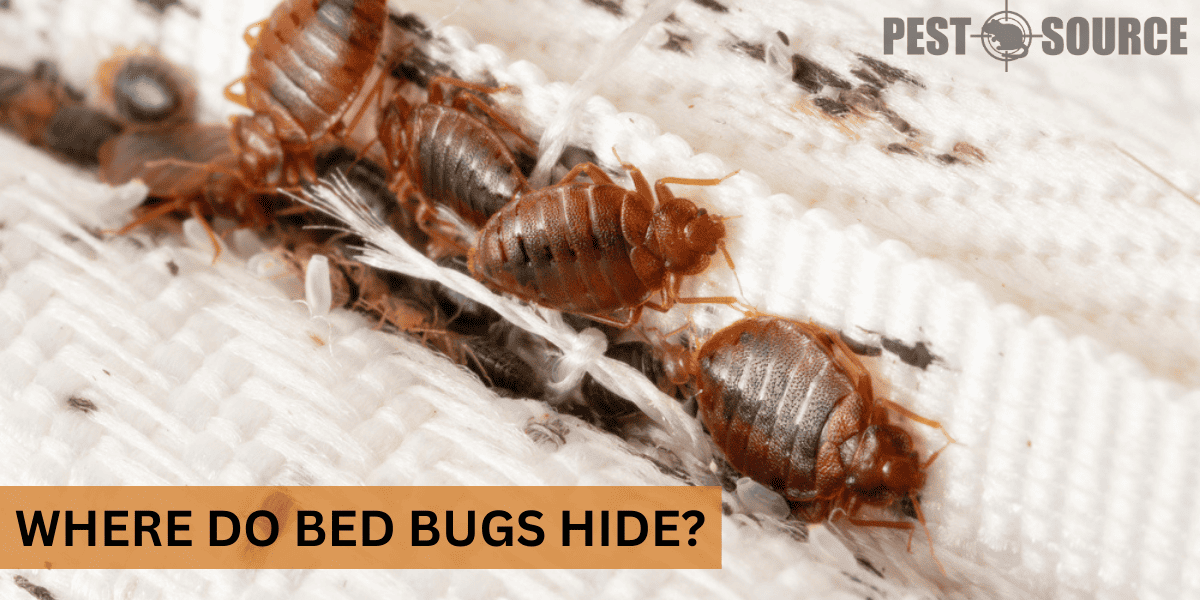Bed bugs hide in close proximity to where people sleep or rest, favoring small crevices and protected spaces. Common hiding spots include mattress seams, bed frames, furniture joints, and even behind wallpapers. Their small size allows them to remain undetected in tiny cracks and crevices. This post will detail their common hiding places and signs to look for, aiding in early detection and effective control of infestations.
POINTS
- Bed bugs are small, nocturnal insects that tend to hide in tiny cracks and crevices in any environment where they have access to a human host. Common hideouts include mattresses, bed frames, upholstered furniture, clothing, luggage, and sometimes even personal belongings like books and electronics.
- These pests spread by ‘hitchhiking’ on people or their belongings as they move, a characteristic that allows them to infest new areas swiftly. They are resilient and breed efficiently, making them a challenge to control.
- The presence of bed bugs can be detected through signs like small, itchy red bites, dark fecal spots, blood stains, a musty odor, or the bugs themselves. Tools like bed bug interceptors, detectors, and even bed bug-detecting dogs can be useful in tracing their hideouts.
- The most effective measure to control a bed bug infestation often involves professional pest control services, which may employ heat treatments, chemical treatments, or a combination to thoroughly tackle the issue.
- To prevent infestations, it’s important to maintain a clean and clutter-free home, encase mattresses and pillows with bed bug-proof covers, wash and heat-dry linens regularly, and inspect belongings frequently. Understanding the hiding places and behaviors of bed bugs is crucial for early detection, prevention, and control.
What Are Bed Bugs and Why Do They Hide?
What are bed bugs?
Bed bugs are small, nocturnal insects that feed on the blood of humans and animals. They are about the size of an apple seed and are reddish-brown in color. Despite their size, these parasites have been a major annoyance for centuries thanks to their bites that cause itching and discomfort.
Why do bed bugs hide?
Bed bugs are experts at hiding as it is their primary means of survival. Being active mostly at night, these insects spend their days hidden in small crevices, making them notoriously hard to detect. They lure in the quiet corners, waiting for your guard to drop, before they venture out to feed.
What environments do bed bugs thrive in?
Bed bugs are not picky about their surroundings. They can thrive in both clean and dirty environments as long as they have access to their food source: humans. They are more commonly associated with areas where people sleep as they are less likely to be disturbed while feeding at night. However, they can be found in a variety of settings, including hotels, apartments, homes, and even public transportation.
Where Do Bed Bugs Typically Hide in Domestic Settings?
How do bed bugs infest homes, and what are their preferred hiding spots?
Bed bugs easily find their way into homes through the clothes we wear, luggage, furniture, or any material that has been in an infested area. Their flattened bodies make it easy for them to hide in minute spaces, waiting to hitch a ride to their next destination.
In homes, bed bugs like to stay close to their food source. They often take cover in mattresses, hiding in the seams, under mattress labels, and within box springs. They also settle inside the nooks of your bed frames, especially the wooden ones, where they can tuck themselves into the smallest crevices.
Do bed bugs hide in mattresses and bed frames?
Yes, mattresses and bed frames are the most common hiding places for bedbugs. They are able to stay close to their food source and they are also able to remain undisturbed during the day. In the tiny gaps within your bed frame and the seams of your mattress, they find the perfect crevice to rest during daylight hours.
Do bed bugs live inside the mattress and how can they be detected?
Yes, bed bugs often dwell inside mattresses. Positioned comfortably, they can slip out during the night, feed, and return undetected. They can be exposed by carefully examining your mattresses for tiny, black or brown spots of bed bug excrement. You may also notice minute blood stains from crushed bugs or shell-like skin sheddings.
Can bed bugs live in upholstered furniture?
Certainly! Upholstered furniture is another favorite hideout for bed bugs. The seams, cushions, or any folds of fabric in your couches, chairs, or recliners are ideal refuges for these bugs, ensuring they remain in close proximity to their human hosts even in the living room or den.
Where do bed bugs hide in other furniture like couches, chairs, and recliners?
Apart from the upholstered parts, bed bugs may also inhabit less obvious areas of your furniture. They can tuck themselves away in the cracks and crevices of wooden, metal, or plastic parts, such as in the spaces beneath cushions, inside curtain folds, or, in extreme infestations, inside the hollow sections of furniture frames.
Can bed bugs hide in clothing, shoes, and luggage, and if so, how do they do it?
Yes, bed bugs are skilled stowaways and can find haven in your clothing, shoes, and luggage. They’re attracted to the warmth and natural scents left on worn clothes. You might find them in the seams, pockets, or folds, making your wardrobe a potential pest reservoir. As for luggage, bed bugs spread from one location to another by stowing away in luggage seams or pockets, riding undetected to your home from trips or visits to infested areas.
Where else can bed bugs be found in a household?
Bed bugs are not just confined to your bedroom or living room. They can also take refuge in areas you’d least expect. This includes your laundry room, particularly in laundry bags and dirty clothes piles, bathroom cabinets, kitchen appliances, and even wall sockets.
Can bed bugs hide in other personal belongings like books, shoes, and electronics?
Surprisingly, yes. Consider every crevice in your house a potential hiding place, including book bindings, shoe interiors, and small electronics. Their ability to squeeze into tiny spaces makes it easy for them to settle into such hideouts and potentially go unnoticed.
Where Can Bed Bugs Hide on the Human Body?
Can bed bugs hide on your body? If so, where?
Although bed bugs typically reside in your belongings, it’s possible but uncommon for them to dwell directly on your body. They prefer a cooler, undisturbed place to safely hide, so they might temporarily attach to clothes, especially loose ones, or within your personal items like purses or backpacks. They’re not equipped to navigate through human hair like lice or ticks, so the human body isn’t their ideal nesting ground. More on where bed bugs hide on your body.
What attracts bed bugs to humans?
Primarily, it’s our exhaled carbon dioxide and body heat that signal a meal to bed bugs. Certain chemicals found in our sweat and skin also lure these pests our way. As they need a blood meal to grow and reproduce, they are highly drawn to humans, seeking us out during their most active period: night.
How Do Bed Bugs Adapt to Different Environments?
Where do bed bugs live in the wild?
While bed bugs are primarily known as household pests, they don’t naturally inhabit the wild. Their ideal habitat is anywhere that provides easy access to their preferred food source – you.
Where can bed bugs be found in nature?
Contrary to common belief, bed bugs are not outdoorsy bugs. They are not found in nests, gardens, or wild animal burrows. They’re typically hitchhikers who latch onto humans or human belongings, eagerly infesting spaces where people sleep or rest.
How do bed bugs hide during the day?
During the day, when their risk of being noticed and eliminated is high, bed bugs skillfully conceal themselves in tiny cracks and crevices within close range of a human host. They squeeze into the snug spaces of your furniture, mattresses, clothes or personal belongings, hiding until their nocturnal feast begins.
Where do bed bugs hide at night?
At night, bed bugs become active. They leave their hiding places and head for their meal – humans. However, they’re still careful to retreat into their hiding spots promptly after feeding, ensuring minimal detection. For them, the night is the ‘day’ to scout, feed, and reproduce. The cycle then repeats, resulting in a rapidly growing infestation if not addressed promptly.
Where Did Bed Bugs Originally Come From?
What is the origin of bed bugs?
Bed bugs have been pesky companions to humans for thousands of years. It’s believed they first evolved from insects that fed on bats and later discovered an abundant food source in humans dwelling in caves. The earliest reported bed bugs from archaeological sites are believed to be over 3,500 years old.
What country do bed bugs come from originally?
Bed bugs are believed to have originated in the Middle East, in caves inhabited by humans and bats. As humans began to form civilizations and trade routes developed, these pests hitchhiked with them, spreading across the globe.
Where are bed bugs native to?
While they were initially native to the Middle East, bed bugs have spread worldwide. They’ve been successful occupants of every continent, infesting every corner of the globe where humans reside.
What is known about the historical distribution and spread of bed bugs?
Historically, bed bugs have been documented in many cultures, from Ancient Greece to medieval Europe. They were common in the U.S. before World War II, after which their numbers declined due to the use of DDT. However, in the past few decades, they’ve made a comeback due to increased international travel, resistance to pesticides, and changes in pest control practices. Today, they are found everywhere, from developing countries to modern cities.
How Can You Find Bed Bugs?
How to find bed bugs during the day?
Checking for bed bugs during the day requires a careful inspection of their potential hideouts. Check the folds, seams, and labels of your mattresses, under baseboards, behind wall hangings, or any cracks and crevices in your furniture. Look for signs such as dark spots or smears (their droppings), shed skins, or the bugs themselves.
Where to find bed bugs in common hiding places?
Familiarize yourself with the common hideouts mentioned earlier in this article. Thoroughly examine your beds, furniture, clothes, and personal belongings, focusing on the hidden parts such as seams, crevices or layered sections.
How can you locate live bed bugs?
Spotting live bed bugs can be challenging due to their size and hiding prowess. They’re mostly active at night, so sometimes inspecting your beds and furniture with a flashlight after midnight might reveal a live bug. Look for tiny, reddish-brown insects that are about the size of an apple seed.
What are the signs of bed bug infestations?
Bed bug infestations can be identified by various signs. These include:
- Small, itchy red bites on your skin, often in a line or cluster
- Dark spots on the mattress, furniture, or sheets, which are bed bug feces
- Blood stains on your sheets, duvets, or pajamas
- A musty, sweet odor in your room
- Finding live bugs or their shed skins in your belongings
Are there tools or techniques to help detect bed bug hiding places?
Yes, there are specialized detection tools available such as bed bug interceptors and detectors. Professional pest control services also use bed bug detecting dogs and heat treatment equipment for severe infestations. Regular home maintenance, decluttering, and careful scrutiny of your belongings, especially after travel, can help in early detection.
How Do Bed Bugs Spread and Infest New Areas?
How do bed bugs move from one place to another?
Bed bugs spread by ‘hitchhiking’ on people or their belongings. If you visit an infested area or come into contact with items that contain bed bugs, you’re likely to unknowingly transport them to your own home. They can also move through wall voids in multi-unit buildings, making them a common nuisance in apartments, hotels, and hospitals.



